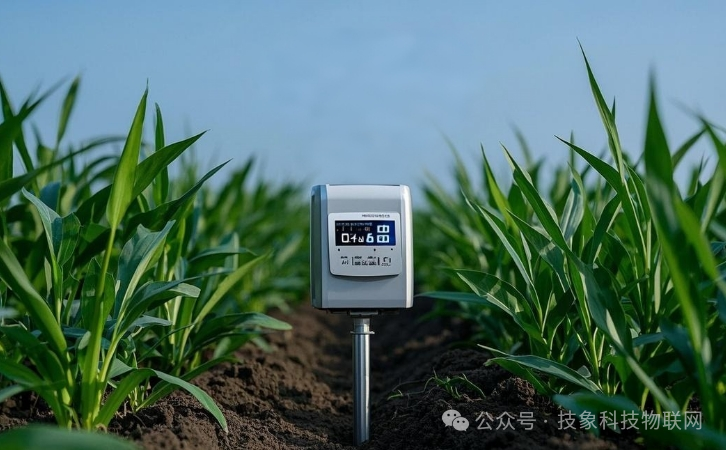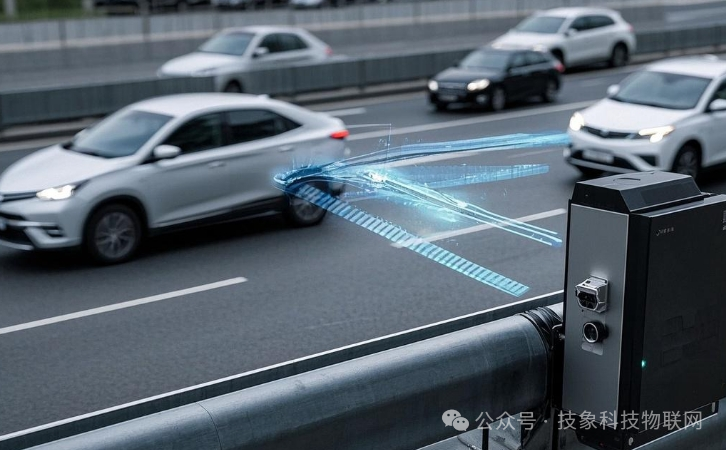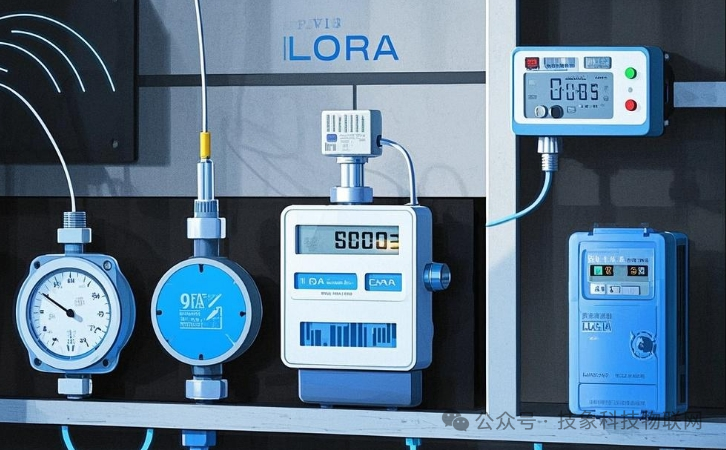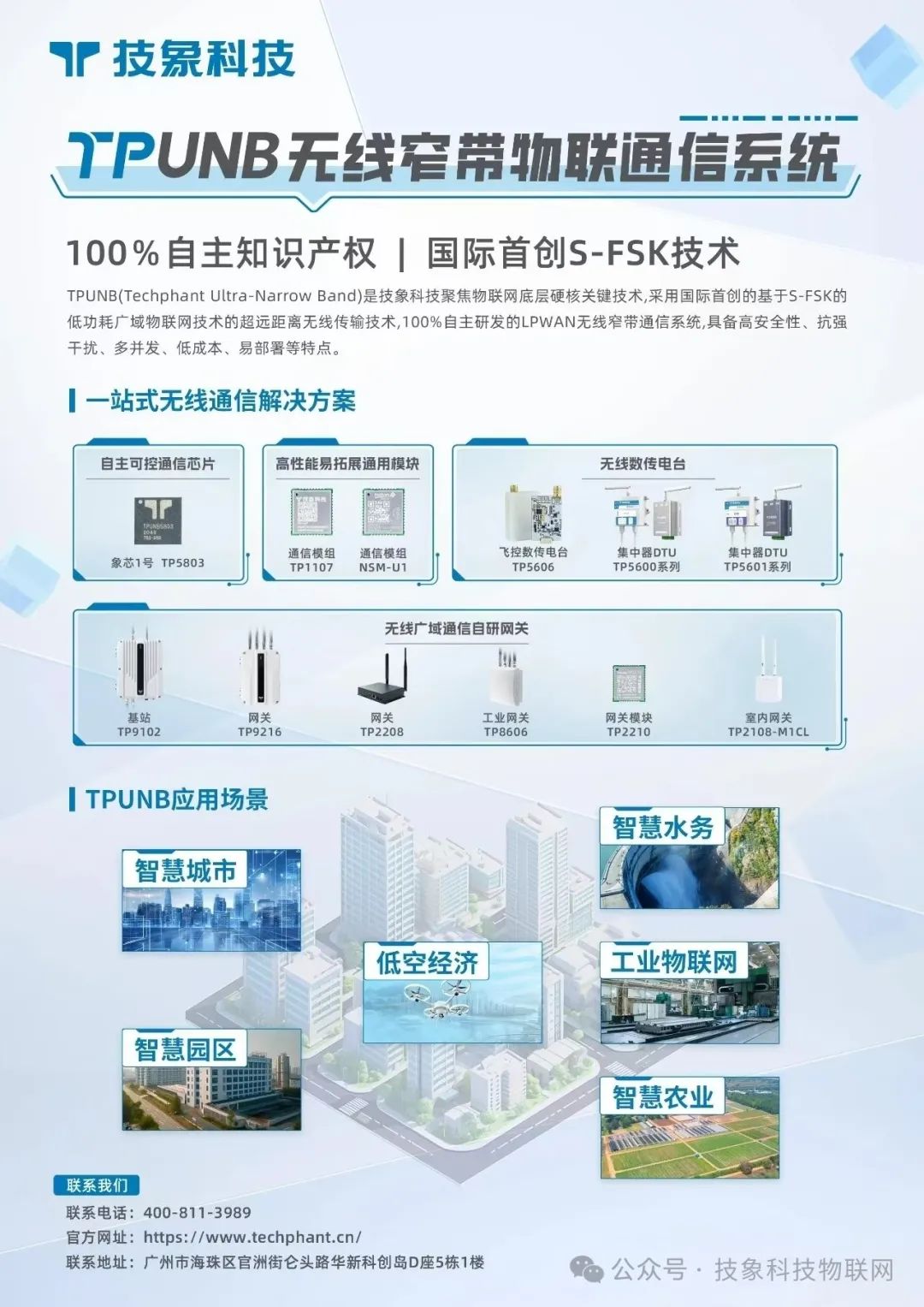Research on the Low Power Mechanism of LoRa Devices

With the rapid development of Internet of Things (IoT) technology, Low Power Wide Area Network (LPWAN) technology has become one of the research hotspots in the field of wireless communication. LoRa technology, as one of the representatives of LPWAN technology, is widely used in smart cities, agricultural monitoring, industrial automation, etc., due to its low power consumption, long range, and high anti-interference capability. The low power characteristics of LoRa devices enable them to operate for extended periods, even on battery power, greatly facilitating the deployment and management of IoT devices. Therefore, in-depth research on the low power mechanism of LoRa devices is of great significance for improving the overall energy efficiency of IoT applications.
1
Low Power Mechanism of LoRa Devices
Low Power Mechanism at the Physical Layer
1. Spread Spectrum Modulation Technology
LoRa’s physical layer employs Linear Frequency Modulation (LFM) spread spectrum modulation technology, which enhances transmission distance and anti-interference capability by expanding the signal bandwidth. Compared to traditional modulation methods, LFM modulation can achieve reliable data transmission in low signal-to-noise ratio environments, thereby reducing the device’s transmission power and achieving low power consumption. The spreading factor (SF) is an important parameter in LFM modulation, typically ranging from 7 to 12. A larger SF increases the signal’s anti-interference capability but correspondingly reduces the transmission rate. By appropriately selecting the SF, a trade-off can be made between transmission rate and communication distance, thus reducing power consumption while ensuring communication quality.
For example, in short-range communication, a smaller SF (such as SF7) can be used to increase the transmission rate and reduce power consumption; while in long-range communication, a larger SF (such as SF12) can be used to ensure communication reliability. Additionally, spread spectrum technology can reduce signal interference, thereby lowering the power consumption of the device when receiving data.
2. Receiver Sensitivity Optimization
LoRa devices have high receiver sensitivity, allowing them to receive data even at weak signal strengths. This means that devices can communicate at lower transmission power, thus reducing energy consumption. The receiver sensitivity of LoRa devices can typically reach -148 dBm, enabling them to operate normally under extremely low signal strengths. Furthermore, LoRa devices can quickly enter a low power standby state when receiving data, further reducing power consumption.
To optimize receiver sensitivity, devices typically use Low Noise Amplifiers (LNA) and high-sensitivity RF front-end modules. These components effectively amplify weak signals while reducing noise interference, thereby improving reception efficiency. By optimizing receiver sensitivity, devices can achieve reliable communication at lower transmission power, significantly reducing power consumption.
Low Power Mechanism at the Application Layer
1. Sleep Mode
LoRa devices can enter sleep mode when not in operation, during which most functional modules of the device stop working, retaining only the necessary wake-up functions. The power consumption in sleep mode is extremely low, typically reaching a few microamps or even lower. This low power state allows devices to operate for extended periods, prolonging battery life.
To further reduce power consumption in sleep mode, devices typically use low-power chips and optimized power management circuits. For example, Semtech’s SX127x series chips can achieve power consumption as low as 2μA in sleep mode. Additionally, devices can further reduce power consumption by turning off unnecessary modules (such as RF modules, sensor modules, etc.).
2. Wake-Up Mechanism
To quickly wake up devices when needed, LoRa devices employ various wake-up mechanisms. For instance, devices can be awakened by timers to perform data collection and transmission at specific intervals; they can also be triggered by external events, such as when a sensor detects a specific event. These wake-up mechanisms ensure low power consumption while maintaining the device’s real-time and responsiveness.
The timer wake-up mechanism typically uses low-power Real-Time Clock (RTC) chips to minimize power consumption. The external event wake-up mechanism requires an efficient interrupt handling mechanism to ensure that devices can quickly respond to external events. By designing wake-up mechanisms appropriately, low power consumption can be ensured while meeting the real-time requirements of IoT applications.
Low Power Mechanism at the Link Layer
1. Adaptive Data Rate (ADR)
Adaptive Data Rate is a mechanism for dynamically adjusting the spreading factor (SF) and bandwidth (BW). By appropriately selecting SF and BW, devices can balance transmission rate and communication distance, thereby reducing power consumption while ensuring communication quality. The core idea of the ADR mechanism is to dynamically adjust transmission parameters based on the communication quality between the device and the gateway.
For example, when the device is close to the gateway, a lower SF (such as SF7) and a smaller BW (such as 125 kHz) can be used to increase the transmission rate and reduce power consumption; while when the device is far from the gateway, a higher SF (such as SF12) and a larger BW (such as 500 kHz) can be used to ensure communication reliability. The ADR mechanism can achieve optimal power performance in different communication environments by dynamically adjusting transmission parameters.
ADR can also be adjusted based on network load and the device’s battery status. For instance, when the device’s battery level is low, lower SF and BW can be prioritized to reduce power consumption; while when network load is high, SF and BW can be increased to ensure reliable data transmission.
2. Preamble Detection
LoRa devices first detect the preamble when receiving data, and only continue to receive data after detecting a valid preamble. The preamble is the initial part of the data packet, used to synchronize the clocks of the receiving and sending ends. This mechanism can prevent devices from remaining in the receiving state for extended periods, thereby reducing power consumption.
The length of the preamble and the detection algorithm significantly impact power consumption. A longer preamble can improve detection reliability but increases detection time; while a shorter preamble can reduce detection time but may lower detection reliability. Therefore, a trade-off must be made between preamble length and detection algorithm to achieve optimal power performance.
2
Power Optimization Methods for LoRa Devices
1
Hardware Optimization
Low Power Chip Selection:Selecting low-power chips is key to achieving low power consumption in LoRa devices. Some specially designed LoRa chips perform excellently in power control, such as Semtech’s SX127x series chips. These chips can achieve power consumption as low as a few microamps in sleep mode, providing strong support for low power operation. Additionally, selecting low-power microcontrollers (MCUs) and sensors is also an important means of reducing power consumption. For example, the STM32L series low-power MCUs can achieve power consumption as low as 1.5μA in sleep mode, making them very suitable for LoRa device design. By selecting low-power chips, significant reductions in device power consumption can be achieved at the hardware level.
Power Management Circuit Design:Reasonable design of power management circuits can further reduce device power consumption. For example, using efficient DC-DC converters can improve power conversion efficiency and reduce energy loss; using power management chips to independently control the power supply to various modules can turn off modules that are not needed, thereby reducing power consumption. Power management circuits can also use Dynamic Voltage Scaling (DVS) technology to dynamically adjust the supply voltage based on the device’s operating state to achieve optimal power performance. For instance, under low load conditions, the supply voltage can be lowered to reduce power consumption; while under high load conditions, the supply voltage can be increased to ensure performance.
2
Software Optimization
Protocol Stack Optimization:Optimizing the LoRa protocol stack can reduce device power consumption. For example, reducing unnecessary protocol overhead, optimizing packet size and transmission frequency can reduce the device’s communication time and energy consumption. Some parameters in the LoRaWAN protocol stack (such as the frequency of acknowledgment messages, number of retransmissions, etc.) can be optimized to lower power consumption. Additionally, the protocol stack can also reduce data transmission volume by adopting lightweight encryption and compression algorithms, thereby lowering power consumption. For example, using the AES-128 encryption algorithm can ensure security while reducing computational complexity and power consumption.
Algorithm Optimization:Using efficient algorithms can reduce the device’s computational complexity, thereby reducing power consumption. For instance, in data processing, lightweight encryption and compression algorithms can be used to reduce the device’s computational load and energy consumption. Furthermore, optimizing data collection and processing algorithms can minimize unnecessary computations, thus lowering power consumption. For example, during sensor data collection, sampling rate optimization and data filtering algorithms can reduce data volume and computational complexity. By designing algorithms reasonably, significant reductions in power consumption can be achieved while ensuring device performance.
3
Power Performance and Influencing Factors of LoRa Devices
Power Performance
Power Consumption in Different Operating Modes:LoRa devices exhibit significant differences in power consumption across different operating modes. In transmission mode, power consumption is highest, typically reaching several hundred milliamps; in reception mode, power consumption is relatively lower, usually in the tens of milliamps; while in sleep mode, power consumption is lowest, potentially as low as a few microamps. Therefore, effectively controlling the device’s operating mode is key to reducing power consumption. For example, the SX1276 chip has a power consumption of 120mA (14 dBm) in transmission mode, 10mA in reception mode, and only 2μA in sleep mode. By reducing transmission and reception time and increasing sleep time, the average power consumption of the device can be significantly lowered.
Power Consumption in Different Application Scenarios:In different application scenarios, the power performance of LoRa devices also varies. For instance, in smart agricultural monitoring, devices typically only need to periodically collect and transmit data, resulting in relatively low power consumption; while in smart transportation, devices need to collect and transmit data in real-time, leading to relatively higher power consumption. In smart agricultural monitoring, devices can control power consumption at a low level by optimizing data collection frequency and transmission strategies. For example, collecting data once an hour and immediately entering sleep mode after collection can significantly reduce power consumption. In smart transportation, devices need to transmit large amounts of data in real-time, which can be achieved by employing adaptive data rate mechanisms and optimizing data transmission strategies to lower power consumption.
Influencing Factors
Transmission Distance:Transmission distance is one of the key factors affecting the power consumption of LoRa devices. The farther the transmission distance, the higher the required transmission power, and thus the higher the power consumption. Therefore, when designing IoT applications, it is necessary to reasonably select the device’s transmission power based on the actual transmission distance. For example, in short-range communication, lower transmission power (such as 10 dBm) can be used to reduce power consumption; while in long-range communication, higher transmission power (such as 20 dBm) may be required to ensure communication reliability. By reasonably selecting transmission power, power consumption can be reduced while ensuring communication quality.
Data Volume:The size of the data volume also affects the device’s power consumption. The larger the data volume, the higher the power consumption during data transmission and reception. Therefore, unnecessary data transmission can be reduced by optimizing data collection and transmission strategies to lower power consumption. For instance, in smart agricultural monitoring, data compression algorithms can be used to reduce data volume, or sampling frequency can be optimized to reduce the number of data collection instances. By reducing data volume, significant reductions in device power consumption can be achieved.
Environmental Factors:Environmental factors such as temperature, humidity, and electromagnetic interference can also impact the device’s power consumption. For example, in high-temperature environments, the device’s power consumption may increase; in environments with strong electromagnetic interference, the device may need to increase transmission power to ensure communication reliability, leading to higher power consumption. To mitigate the impact of environmental factors on power consumption, hardware design and deployment location can be optimized to reduce interference. For example, selecting low-noise RF front-end modules or deploying devices in areas with less interference can help.
4
Case Studies
1
Smart Agricultural Monitoring Case
In smart agricultural monitoring applications, LoRa devices are widely used for collecting and transmitting data such as soil moisture and temperature. By adopting low power designs, devices can operate for years on battery power. Test results indicate that the power consumption of devices in sleep mode can be as low as 2μA, while in transmission mode, it is around 120mA. By appropriately setting the data collection and transmission frequency, the average power consumption of the device can be effectively controlled. For example, collecting data once an hour and immediately entering sleep mode after collection can reduce the average power consumption to as low as 50μA. By optimizing data collection and transmission strategies, the battery life of the device can be extended to over 5 years.

2
Smart Transportation Case
In the smart transportation field, LoRa devices are used for collecting and transmitting vehicle information. Due to the need for real-time transmission of large amounts of data, the power consumption of devices is relatively high. Test results indicate that the power consumption of devices in transmission mode can reach around 200mA. By employing adaptive data rate mechanisms and optimizing data transmission strategies, the power consumption of devices has been effectively reduced. For example, in short-range communication, using a lower spreading factor (such as SF7) and a smaller bandwidth (such as 125 kHz) can significantly reduce power consumption; while in long-range communication, using a higher spreading factor (such as SF12) and a larger bandwidth (such as 500 kHz) can ensure communication reliability. By dynamically adjusting transmission parameters, the power consumption of devices can be reduced to around 150mA while ensuring real-time and reliable data transmission.

3
Smart Home Metering System Case
In smart home metering systems, LoRa devices are widely used for data collection and transmission of water meters, electricity meters, and gas meters. These devices are often installed in hard-to-reach locations and need to operate for long periods, making low power characteristics crucial. By adopting LoRa technology, these devices can operate for years on battery power, significantly reducing maintenance costs and the frequency of manual meter reading. Smart home metering devices using LoRa technology can achieve power consumption as low as 2μA in sleep mode, while in data transmission mode, power consumption is around 100mA. By optimizing the timed wake-up mechanism and data transmission strategies, the average power consumption of the devices can be kept at a low level, extending battery life to over 5 years. The low power design not only extends the lifespan of the devices but also enhances system reliability. Users do not need to frequently replace batteries, reducing maintenance costs and inconvenience. At the same time, the real-time and responsiveness of the devices are ensured, guaranteeing the accuracy and timeliness of meter reading data, thus enhancing the user experience.

5
Conclusion
The low power mechanism of LoRa devices is of great significance in IoT applications. By thoroughly studying the low power mechanisms of LoRa devices at the physical layer, link layer, and application layer, we have detailed the working principles and optimization methods of key technologies such as spread spectrum modulation technology, adaptive data rate, preamble detection, sleep mode, and wake-up mechanisms. Practical tests and case analyses indicate that the power performance and influencing factors of LoRa devices vary across different application scenarios. By reasonably optimizing hardware and software design, further reductions in device power consumption can be achieved, extending device lifespan and enhancing the overall energy efficiency of IoT applications.
In the future, with the continuous development of IoT technology, the low power mechanisms of LoRa devices will see broader applications and deeper research. For example, by introducing artificial intelligence and machine learning technologies, further optimization of device power performance can be achieved; by adopting new low-power chips and materials, device power consumption can be further reduced. The development of these technologies will provide strong support for achieving a more intelligent and efficient IoT ecosystem.
